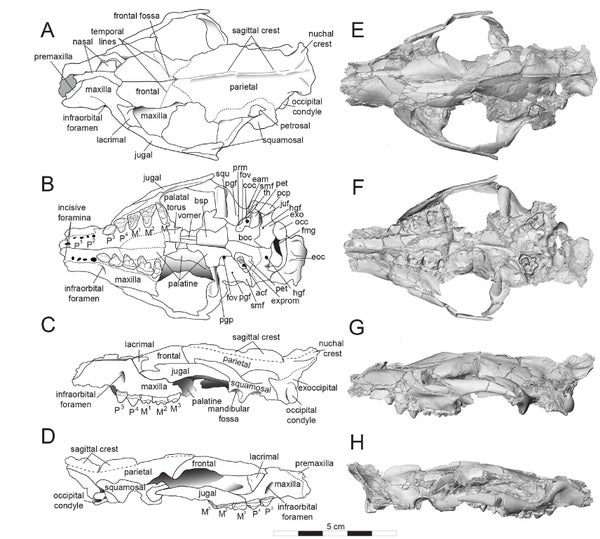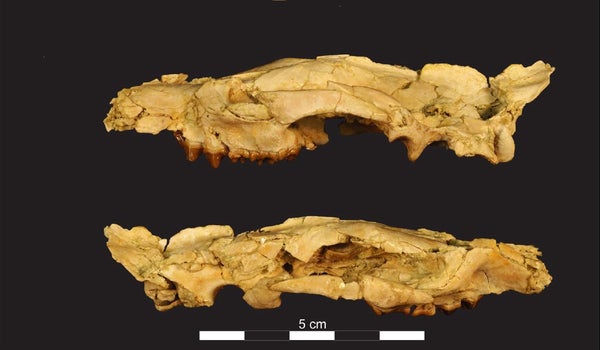This article was published in Scientific American’s former blog network and reflects the views of the author, not necessarily those of Scientific American
The deep past can be a confounding place to visit. More forms of life have evolved and vanished than we see around us today, many lineages completely coming to an end and leaving us with no modern representatives to understand them. Among these confounding creatures are the hyaenodonts, carnivorous mammals that were top predators before cats and dogs claimed the title.
Paleontologists primarily know hyaenodonts from the fossil record of North America and Eurasia. To our modern eyes, these fearsome carnivores would look like mashups of dogs, cats, hyenas, and Tasmanian tigers. But, as paleontologists Matthew Borths and Erik Seiffert write in a new study, the earliest hyaenodonts are from ancient Afro-Arabia, including a species the researchers have just named.
Masrasector nananubis wasn't a beast that would make you run in terror. This archaic carnivore was about the size of a skunk. And in their analysis of the mammal's teeth and preserved limb fragments, Borths and Seiffert concluded that this "little Anubis" was a quick runner that had enjoyed a diverse diet that could have included fruits, nuts, and insects in addition to fleshier fare. Today's genets and other small carnivores are filling the role Masrasector pioneered over 34 million years ago.

Sketches and scans of Masrasector nananubs. Credit: Borths and Seiffert 2017
Fossil Facts
On supporting science journalism
If you're enjoying this article, consider supporting our award-winning journalism by subscribing. By purchasing a subscription you are helping to ensure the future of impactful stories about the discoveries and ideas shaping our world today.
Name: Masrasector nananubis
Meaning: Masrasector is a genus of hyaenodont named in 1974, and nananubis means "little Anubis" in reference to the ancient Egyptian god.
Age: Eocene, about 34 million years ago.
Where in the world?: Fayum Depression, Egypt.
What sort of organism?: A carnivorous mammal called a hyaenodont.
Size: Small, about the size of a skunk.
How much of the organism’s is known?: A nearly complete cranium, lower jaws, skull fragments, and parts of the upper arm.
Reference:
Borths, M., Seiffert, E. 2017. Craniodental and humeral morphology of a new species of Masrasector (Teratodontinae, Hyaenodonta, Placentalia) from the late Eocene of Egypt and locomotor diversity in hyaenodonts. PLOS ONE. doi: 10.1371/journal.pone.0173527
Previous Paleo Profiles:
The Light-Footed Lizard The Maoming Cat Knight’s Egyptian Bat The La Luna Snake The Rio do Rasto Tooth Bob Weir's Otter Egypt's Canine Beast The Vastan Mine Tapir Pangu's Wing The Dawn Megamouth The Genga Lizard The Micro Lion The Mystery Titanosaur The Echo Hunter The Lo Hueco Titan The Three-Branched Cicada The Monster of Minden The Pig-Footed Bandicoot Hayden's Rattlesnake Demon The Evasive Ostrich Seer The Paradoxical Mega Shark The Tiny Beardogs The Armored Fish King North America's Pangolin The Invisible-Tusked Elephant The Mud Dragon The Spike-Toothed Salmon The Dream Coast Crocodile Buriol's Robber Ozimek's Flyer The Northern Naustoceratopsian The High Arctic Flyer The Tomatillo From the End of the World The Short-Faced Hyena The Mighty Traveler from Egg Mountain Keilhau's Ichthyosaur Mexico's Ancient Horned Face Mauricio Fernández's Plesiosaur New Zealand's Giant Dawn Penguin The Orange Sea Lion Mongolia's Ginkgo Cousin The Geni River Frog Isabel Berry's Dinosaur The Whale Caiman The Moab Lizard Yang Zhongjian's Lizard
